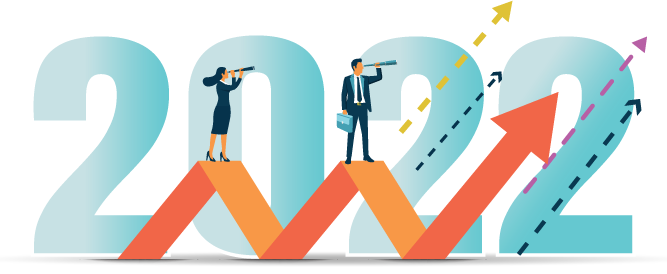
If you’ve been hanging on for dear life during the roller coaster ride that was the last two years, HOLD ON TIGHT, because there’s more to come. Yes — we’ve been through the almightiest HR journey that has occurred for generations. At the start of 2021, a lot of us thought that with a raft of different vaccines on the way, it would only be a matter of time before we’d have a full return to the office and some feeling of normalcy. But that wasn’t to be. Australia and New Zealand were dealt a series of blows, with new lockdowns seriously affecting our ability to return to the workplace. Then there was the emergence of new COVID variants like Omicron. And a new war for talent emerged, along with the doom, gloom and scaremongering about what became known as The Great Resignation. In this 2022 trends special, we’ll explore why this won’t be the year when things go back to normal, even despite a number of green shoots emerging for HR professionals.
So, what does 2022 hold for HR? — and what are the key trends to look out for? Firstly, don’t expect Omicron to be the only COVID variant to be on the tip of people’s tongues. New variants are expected to emerge that will cause workplaces to go remote again. Hybrid work will continue to mean great flexibility is needed in where, when and how people do their work. Another thing — inflation. In New Zealand, inflation surged at the fastest pace in 10 years during the third quarter of 2021. This runaway in price rises means that people are feeling the effect of less spending power, equivalent to a drop in their annual compensation. A powerful cocktail of factors means that you should prepare yourself for a number of key trends this year.
1. Fairness, equity and equality will be right at the top of the corporate HR agenda
COVID exposed great fairness gaps around race, climate change and even COVID vaccine distribution. According to Gartner, CEOs talked about equity, fairness and inclusion 658% more during 2021 than they did in 2018. Leaders and HR professionals have had to make urgent decisions regarding the way people work. In some organisations, groups were given greater flexibility and support than others. There were cases where those without vaccinations were told they’d receive less sick pay. Meanwhile, in some sectors and business units, amid the ‘war for talent’ employees have been offered salaries at a premium. Is it fair for them to do this? — and do leadership need to be transparent about this practice? After all, loyal long-standing talent feel they shouldn’t be left out too. During the various lockdowns, some employers went to extraordinary lengths to support employees with children. But once again, the issue of fairness cropped up. Childless employees felt they shouldn’t be left short of additional pay, benefits or other concessions. Leaders have been talking about this issue more and more — so don’t expect this to be off the table anytime soon. Prepare for frank discussions about fairness and the way it affects the employee experience in the coming months.

2. Say hello to the 32-hour workweek
So the experts and analysts at Gartner spend millions on doing some of the most detailed research into global business and workplace trends. They recently reported that they’ve seen employers offering a significant increase in pay to attract and retain people during these turbulent times. For example, instead of a 2% annual pay increase, they’ve seen higher figures more in the region of 4% (lucky for some). But when you factor in the effect of inflation, people’s real take-home wages have declined — and if inflation continues to increase, it will seriously erode people’s purchasing power. The ability to compete for talent with deep pockets alone is the reserve of large organisations in particular industries. What about ordinary companies and their small and medium-sized counterparts. Well, according to Gartner, they’ve seen employers deploy a new strategy. Instead of trying to compete with hordes of money, they are keeping salaries the same, but reducing the number of hours worked. Yes — the 4-day, 32-hour workweek is a thing. Now, before you get too excited (or worried), it’s initially only expected that a handful of employers (in the grand scheme of things) will initially do this. It’s not going to apply equally across the board — we’re referring here to prized knowledge workers who have the clout to choose between higher pay or more free leisure time. Which will they take? So, this year — expect to see more and more stories in the media about the 4-day week.
3. Employee turnover is here to stay - in fact, it will continue to increase
Flexibility used to be a differentiator — it was a benefit that made some employers stand out from the crowd. Now it’s expected — it’s considered a given. So, employers that refuse to budge can expect people to move onto places that offer a fairer and more considered employee experience.
However, flexibility doesn’t solve the employee turnover problem. In fact, this added flexibility is likely going to lead to further rises in employee leakage. Why? — you may ask… Employees who regularly work from home (or remotely) will have less friends in the workplace and the bonds between co-workers won’t be as strong. When you spend 8 hours a day working next to someone, strong friendships and emotional bonds can form over time. Occasional conversations via Zoom are unlikely to have the same effect. Peer pressure in the office can encourage people to stay in their jobs for longer — but with the hybrid workplace, the peer effect will be reduced.
There’s another reason why increased flexibility will likely lead to more employee attrition. When the world of work was location-centric, people applied for jobs in their own city or within a commutable distance of their home. With remote and hybrid work, it opens up whole new geographies for people to explore. So, if people can’t find a better job nearby, they’ll likely look much further afield (even if it means them having to visit there once in a blue moon). Think about it.

4. Thanks to technology, managers will be liberated to spend more time coaching and building real human relationships
The importance of quality time between managers and their teams has never been more important. With the hybrid workforce, the manager is the glue between the organisation and the employee and the primary source of the employee experience delivered. In 2022, expect to see more and more companies adopt cloud-based Performance Management software and a host of other HR tools that promise to free you up from spreadsheets and manual admin. These systems will automate a lot of the manual ‘humdrum’ that keeps managers tied up, allowing them to spend more time delivering 1-2-1 coaching as part of a performance management-based approach. According to the researchers at Gartner, up to 65% of the tasks that a manager currently does could be automated by 2025. Long term, this will mean that managers will spend less time checking work and more time delivering a holistic experience for employees. This will include their wellbeing, mental health and the realisation of long-term career development aspirations. Even today, Performance Management systems take away a lot of the grunt work, allowing managers to identify skills gaps or employees that need extra help, support and assistance.
5. Video collaboration is about to get a whole lot smarter
Before COVID graced our shores - people were already using video tools like Zoom, WebEx and Teams. But in many cases, people were still camera shy! Well, we’ve all been transformed — and being camera-ready is the norm. People have upped their video collaboration game — and sales of concealers and other skin-enhancing serums have gone through the roof! But reliance on video collaboration tools has gone on to cause a huge amount of bias when it comes to performance ratings. Gartner surveyed almost 3000 managers in autumn 2020. An eye-opening 64% of managers and leaders believed that office-based workers are better performers than their remote counterparts. Worryingly, 76% of those executives also thought that their office-based staff was more likely to be promoted. It means that remote workers really are at a disadvantage when it comes to career development and advancement. Technology may be coming to the rescue — the same platforms that are enabling remote collaboration are likely to soon offer more immersive experiences, bringing people together in a more realistic fashion. This will allow managers to better understand and value the contributions that people are making, no matter where they are located.

6. Wellness will take on an even more important role for HR leaders
You might think that without the commute, people might have made the decision to use that time to become more active. You know — trying new things like body-pump, cross-fit or a bit of that hot yoga? Well, that couldn’t be further from the truth. People piled on the pounds during lockdown — a lot of it from stress-induced over-eating and over-treating. Whilst 35% of people lost weight over the pandemic — 40% gained weight, a serious health risk indicator. For many, the commute was the one thing that got them out of the house and walking! Without the commute and the movement around the office, many have become completely sedentary. Their only exercise is movements in and out of the kitchen. In 2022, expect employers of all sizes to ramp up their wellness efforts. This will mean the launch of wellness offerings that truly support the full workforce — including those working hybrid. Holistic wellness packages will go beyond just providing a % of a gym membership. In 2022, companies will launch schemes that address mental wellness, physical wellness, and even financial wellness. Improvements in these areas will translate into greater productivity, greater engagement and will reduce the time taken off sick. Whilst the rollout of these programmes will initially mean some dollars are taken from the bottom line, overall, they will deliver a tangible and positive ROI.
Conclusion
The world continues to change apace. If there’s anything we’ve learned over the last two years, it’s never to underestimate what kind of turbulence or opportunity might be around the corner. The only constant is change — and with change comes new challenges for the HR leaders. Whatever 2022 brings, the raft of predicted trends bring new ways to bring the best out of the workforce and develop talent. Whatever happens, the show must go on! Stay calm, be prepared and go and make it happen.







